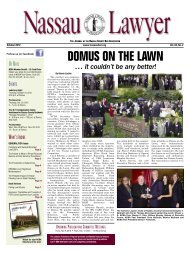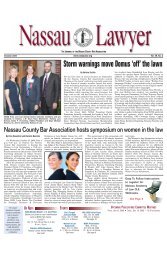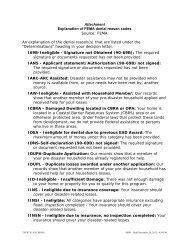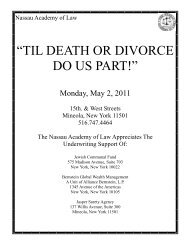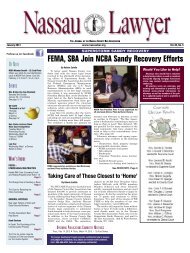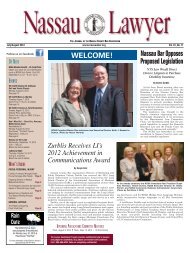397 B.R. 642 Page 5397 B.R. 642(Cite as: 397 B.R. 642)erence into a Judgment <strong>of</strong> Divorce, which specificallyprovided as follows:Ordered and Adjudged that the settlement agreementdated September 19, 2003, a copy <strong>of</strong> which is on filewith the Court, shall be incorporated by reference intothis judgment, shall survive and not merge in thisjudgment, and the parties hereby are directed to complywith every legally enforceable term and provision <strong>of</strong>such settlement agreement.The Judgment <strong>of</strong> Divorce was entered on December 10,2003.10. The state court issued its Findings <strong>of</strong> Fact and Conclusions<strong>of</strong> <strong>Law</strong> in the *647 Divorce Action. [FN2] TheFindings <strong>of</strong> Fact and Conclusions <strong>of</strong> <strong>Law</strong>, along withthe Judgment <strong>of</strong> Divorce, specifically refer to the SettlementAgreement and incorporate the specific terms<strong>of</strong> the Settlement Agreement into the Judgment <strong>of</strong> Divorce.FN2. Based upon the incomplete copy <strong>of</strong> theState Court's Findings and Conclusions the Defendantprovided the Court, this Court cannot ascertainthe entry date <strong>of</strong> the Findings and Conclusions.11. At the time the Judgment <strong>of</strong> Divorce was entered,and as <strong>of</strong> the time Debtor transferred his interest in theMarital Residence to Defendant, the Marital Residencehad a value <strong>of</strong> $532,000 and was subject to a mortgagelien in favor <strong>of</strong> Wells Fargo in the amount <strong>of</strong> $140,000.Thus, prior to the division <strong>of</strong> marital property, and absentother adjustments, the Debtor was entitled to 50%<strong>of</strong> the net equity value <strong>of</strong> $392,000, being an amountequal to $196,000.12. On March 15, 2004, Debtor filed a voluntary petitionfor relief under Chapter 7 <strong>of</strong> the United StatesBankruptcy Code. Thus, this bankruptcy case was filedninety-five (95) days after the Judgment <strong>of</strong> Divorce wasentered, and one hundred and twenty-five (125) daysafter Debtor transferred his interest in the Marital Residenceto Defendant.Legal AnalysisThe Standard for Summary JudgmentPursuant to Rule 56(c) <strong>of</strong> the Federal Rules <strong>of</strong> Civil Procedure,incorporated by Bankruptcy Rule 7056(c), summaryjudgment should be granted to the moving party ifthe Court determines that "the pleadings, depositions,answers to interrogatories, and admissions on file, togetherwith affidavits, if any, show that there is no genuineissue as to any material fact and that the moving partyis entitled to judgment as a matter <strong>of</strong> law." Celotex Corp.v. Catrett, 477 U.S. 317, 322, 106 S.Ct. 2548, 91 L.Ed.2d265 (quoting Fed.R.Civ.P. 56(c)); Anderson v. LibertyLobby, Inc., 477 U.S. 242, 247- 48, 106 S.Ct. 2505, 91L.Ed.2d 202 (1986); Matsushita Elec. Indus. Co. v. ZenithRadio Corp., 475 U.S. 574, 586-87, 106 S.Ct. 1348, 89L.Ed.2d 538 (1986).In considering cross-motions for summary judgment, theCourt must evaluate the merits <strong>of</strong> each motion independently<strong>of</strong> the other. Heublein, Inc. v. United States, 996F.2d 1455, 1461 (2d Cir.1993); In re Rodriguez, 50 B.R.576 (Bankr.E.D.N.Y.1985) ("[C]ross-motions for summaryjudgment do not warrant the court in granting summaryjudgment unless one <strong>of</strong> the moving parties is entitledto judgment as a matter <strong>of</strong> law upon facts that are notgenuinely disputed.")A movant has the initial burden <strong>of</strong> establishing the absence<strong>of</strong> any genuine issue <strong>of</strong> material fact. Celotex, 477U.S. at 322-23, 106 S.Ct. 2548. A fact is "material" if it"might affect the Page 6 <strong>of</strong> 29 outcome <strong>of</strong> the suit underthe governing law." Anderson, 477 U.S. at 248, 106 S.Ct.2505. An issue <strong>of</strong> fact is genuine "if the evidence is suchthat a reasonable jury could return a verdict for the nonmovingparty." Id. "When summary judgment is sought,the moving party bears an initial burden <strong>of</strong> demonstratingthat there is no genuine dispute <strong>of</strong> material fact to be decidedwith respect to any essential element <strong>of</strong> the claim inissue; the failure to meet this burden warrants denial <strong>of</strong>the motion." Smith v. Goord, No. 9:06-CV-401(FJS/DEP), 2008 WL 902184 *4 (N.D.N.Y. Mar.31,2008) (citing Anderson, 477 U.S. at 250 n. 4, 106 S.Ct.2505).If the movant meets his initial burden, the nonmovingparty "must do more than simply show that there is somemetaphysical *648 doubt as to the material facts."Matsushita, 475 U.S. at 586, 106 S.Ct. 1348. Rather, itmust present "significant probative evidence" that a genuineissue <strong>of</strong> fact exists. Anderson, 477 U.S. at 249, 106S.Ct. 2505 (quotation omitted). "There is no issue for trialunless there exists sufficient evidence in the record favoringthe party opposing summary judgment to support ajury verdict in that party's favor." Cadle Co. v. Newhouse,No. 01 Civ. 1777(DC), 2002 WL 1888716 *4(S.D.N.Y.2002) (citing Anderson, 477 U.S. at 249, 106S.Ct. 2505); see also Anderson, 477 U.S. at 250, 106 S.Ct.2505 (finding that summary judgment is appropriate onlywhen "there can be but one reasonable conclusion as tothe verdict").© 2009 Thomson Reuters. No Claim to Orig. US Gov. Works.
397 B.R. 642 Page 6397 B.R. 642(Cite as: 397 B.R. 642)As part <strong>of</strong> the independent evaluation <strong>of</strong> cross-motionsfor summary judgment, the court must draw all reasonableinferences against the party whose motion is underconsideration. Coach, Inc. v. Peters, 386 F.Supp.2d 495,497 (S.D.N.Y.2005); see also Considine v. Schachter(Inre Schachter), No. 05- 9404, 2007 WL 2238293(Bankr.S.D.N.Y. Aug.1, 2007).Standards for Avoidance under Bankruptcy Code Sections544(b), 547 and548Bankruptcy Code Section 544(b) authorizes the Trusteeto avoid "any transfer <strong>of</strong> an interest <strong>of</strong> the debtor in propertyor any obligation incurred by the debtor that is voidableunder applicable law by a creditor holding an unsecuredclaim...." 11 U.S.C. § 544(b)(1). The "applicablelaw" upon which the Trustee relies is set forth in Sections273, 275, 276, 276-a, 278 and 279 <strong>of</strong> New York Debtorand Creditor <strong>Law</strong> ("DCL") and is discussed below.Section 547 <strong>of</strong> the Bankruptcy Code, authorizes the Trusteeto avoid a transfer which prefers one creditor oversimilarly situated creditors, and allows the transferee toreceive more than it would have received in a Chapter 7case had the transfer not been made. 11 U.S.C. § 547.Bankruptcy Code Section 548(a), in effect when theDebtor filed this case, authorized the Trustee to avoid atransfer made for less than reasonably equivalent valuewithin one (1) year prior to the petition date. [FN3]FN3. Prior to the October 17, 2005, amendmentsto the Bankruptcy Code provided under theBankruptcy Abuse Prevention and ConsumerProtection Act ("BAPCPA"), the applicablelook-back period under § 548(a) was one (1)year. Section 548(a) was amended to provide atwo (2)-year lookback. This bankruptcy case wasfiled prior to the effective date <strong>of</strong> the relevantBAPCPA amendments, and this Court appliesthe Bankruptcy Code and Rules as they existedprior to the enactment <strong>of</strong> BAPCPA.Standards for Avoidance <strong>of</strong> Fraudulent Conveyancesunder New York <strong>Law</strong>[1][2] Under New York law, a transfer can be a fraudulentconveyance either as the result <strong>of</strong> actual intent by thetransferor to hinder, delay or defraud, or as the result <strong>of</strong>the financial status <strong>of</strong> the transferor and the economicequivalence <strong>of</strong> the transaction. A constructively fraudulenttransfer will occur where the transfer is made withoutfair consideration as defined by DCL Section 272 and (1)the transferor will be rendered insolvent (DCL § 273), or(2) the transferor intends or believes that he or she willincur debts beyond his or her ability to pay them as theymature (DCL § 275). [FN4] See In re Manshul Constr.Corp., No. 96B44080(JHG),2000 WL 1228866 *48-49(S.D.N.Y. Aug.30, 2000)(citing *649MFS/Sun LifeTrust-High Yield Series v. Van Dusen Airport Servs. Co.,910 F.Supp. 913, 936 (S.D.N.Y.1995)). In general, theplaintiff bears the burden <strong>of</strong> proving the lack <strong>of</strong> fair consideration.United States v. McCombs, 30 F.3d 310, 324(2d Cir.1994).FN4. N.Y. Debt. & Cred. <strong>Law</strong> § 274, which isnot implicated by the Amended Complaint, alsodeals with constructive intent fraudulent conveyanceswhere the transferor is engaged in businessand will be left with unreasonably small capital.DCL § 272 defines "fair consideration" as follows:Fair consideration is given for property or obligation,a. When in exchange for such property, or obligation, asa fair equivalent therefor, and in good faith, property isconveyed or an antecedent debt is satisfied, orb. When such property, or obligation is received ingood faith to secure a present advance or antecedentdebt in amount not disproportionately small as comparedwith the value <strong>of</strong> the property, or obligation obtained.DCL § 272 (McKinney's 2008).[3] Courts generally agree that the concept <strong>of</strong> fair consideration"can be an elusive one that defies any one preciseformula," and that a determination as to whether fair considerationhas been made turns on the facts <strong>of</strong> each specificcase. See McCombs, 30 F.3d at 326.[4] DCL § 276 governs a fraudulent conveyance madewith actual intent and provides: [FN5]FN5. The Trustee also seeks to recover attorneys'fees and expenses pursuant to DCL § 276-a. Underthis Section <strong>of</strong> New York law, the Trusteemay recover his fees and expenses only if he isable to prove that a fraudulent conveyance madewith actual intent occurred.Every conveyance made and every obligation incurredwith actual intent, as distinguished from intent presumedin law, to hinder, delay, or defraud either present© 2009 Thomson Reuters. No Claim to Orig. US Gov. Works.
- Page 1 and 2:
Nassau Academy of LawCLE Live Class
- Page 3 and 4:
McKinney's Debtor and Creditor Law
- Page 5 and 6:
McKinney's Debtor and Creditor Law
- Page 7 and 8:
McKinney's Debtor and Creditor Law
- Page 9 and 10:
McKinney's Debtor and Creditor Law
- Page 11 and 12:
McKinney's Debtor and Creditor Law
- Page 13 and 14:
McKinney's Debtor and Creditor Law
- Page 15 and 16:
McKinney's Debtor and Creditor Law
- Page 17 and 18:
McKinney's Debtor and Creditor Law
- Page 19 and 20:
BAKER & HOSTETLER LLP45 Rockefeller
- Page 21 and 22:
usiness of defendant Bernard L. Mad
- Page 23 and 24:
BACKGROUND, THE TRUSTEE, AND STANDI
- Page 25 and 26:
Madoff who received fraudulent tran
- Page 27 and 28:
ased on fictitious profits and for
- Page 29 and 30:
28. BLMIS funds were also used to p
- Page 31 and 32:
Madoff, and her niece, Shana Madoff
- Page 33 and 34:
42. Ruth Madoff was never an employ
- Page 35 and 36:
FIRST CAUSE OF ACTIONTURNOVER AND A
- Page 37 and 38:
66. At the time of each of the Two-
- Page 39 and 40:
Transfers; (b) directing that the S
- Page 41 and 42:
EIGHTH CAUSE OF ACTIONUNDISCOVERED
- Page 43 and 44:
TENTH CAUSE OF ACTIONDISALLOWANCE O
- Page 45 and 46: 111. Mrs. Madoff benefited from the
- Page 47 and 48: WHEREFORE, the Trustee respectfully
- Page 49 and 50: 2(c)(3): (a) preserving the Subsequ
- Page 51 and 52: 302 B.R. 760 Page 1302 B.R. 760(Cit
- Page 53 and 54: 302 B.R. 760 Page 3302 B.R. 760(Cit
- Page 55 and 56: 302 B.R. 760 Page 5302 B.R. 760(Cit
- Page 57 and 58: 302 B.R. 760 Page 7302 B.R. 760(Cit
- Page 59 and 60: 302 B.R. 760 Page 9302 B.R. 760(Cit
- Page 61 and 62: 302 B.R. 760 Page 11302 B.R. 760(Ci
- Page 63 and 64: 302 B.R. 760 Page 13302 B.R. 760(Ci
- Page 65 and 66: 302 B.R. 760 Page 15302 B.R. 760(Ci
- Page 67 and 68: 302 B.R. 760 Page 17302 B.R. 760(Ci
- Page 69 and 70: 302 B.R. 760 Page 19302 B.R. 760(Ci
- Page 71 and 72: 394 B.R. 721 Page 1394 B.R. 721, 50
- Page 73 and 74: 394 B.R. 721 Page 3394 B.R. 721, 50
- Page 75 and 76: 394 B.R. 721 Page 5394 B.R. 721, 50
- Page 77 and 78: 394 B.R. 721 Page 7394 B.R. 721, 50
- Page 79 and 80: 394 B.R. 721 Page 9394 B.R. 721, 50
- Page 81 and 82: 394 B.R. 721 Page 11394 B.R. 721, 5
- Page 83 and 84: 394 B.R. 721 Page 13394 B.R. 721, 5
- Page 85 and 86: 394 B.R. 721 Page 15394 B.R. 721, 5
- Page 87 and 88: 394 B.R. 721 Page 17394 B.R. 721, 5
- Page 89 and 90: 394 B.R. 721 Page 19394 B.R. 721, 5
- Page 91 and 92: 394 B.R. 721 Page 21394 B.R. 721, 5
- Page 93 and 94: 397 B.R. 642 Page 2397 B.R. 642(Cit
- Page 95: 397 B.R. 642 Page 4397 B.R. 642(Cit
- Page 99 and 100: 397 B.R. 642 Page 8397 B.R. 642(Cit
- Page 101 and 102: 397 B.R. 642 Page 10397 B.R. 642(Ci
- Page 103 and 104: 397 B.R. 642 Page 12397 B.R. 642(Ci
- Page 105 and 106: 397 B.R. 642 Page 14397 B.R. 642(Ci
- Page 107 and 108: 443 F.3d 180 Page 2443 F.3d 180(Cit
- Page 109 and 110: 443 F.3d 180 Page 4443 F.3d 180(Cit
- Page 111 and 112: 443 F.3d 180 Page 6443 F.3d 180(Cit
- Page 113 and 114: 443 F.3d 180 Page 8443 F.3d 180(Cit
- Page 115 and 116: 443 F.3d 180 Page 10443 F.3d 180(Ci
- Page 117 and 118: 443 F.3d 180 Page 12443 F.3d 180(Ci
- Page 119 and 120: Page 2257 A.D.2d 526, 684 N.Y.S.2d
- Page 121 and 122: Page 4257 A.D.2d 526, 684 N.Y.S.2d
- Page 123 and 124: Page 6257 A.D.2d 526, 684 N.Y.S.2d
- Page 125 and 126: 770 N.Y.S.2d 421 Page 22 A.D.3d 780
- Page 127 and 128: Page 14 A.D.3d 495, 773 N.Y.S.2d 71
- Page 129: Page 34 A.D.3d 495, 773 N.Y.S.2d 71
- Page 132 and 133: 780 N.Y.S.2d 409 Page 29 A.D.3d 553
- Page 134 and 135: Page 134 A.D.3d 231, 824 N.Y.S.2d 3
- Page 136 and 137: Page 334 A.D.3d 231, 824 N.Y.S.2d 3
- Page 138 and 139: Page 2991 F.2d 31(Cite as: 991 F.2d
- Page 140 and 141: Page 4991 F.2d 31(Cite as: 991 F.2d
- Page 142 and 143: Page 6991 F.2d 31(Cite as: 991 F.2d
- Page 144 and 145: FRAUDULENT TRANFERENCESRonald M. Te
- Page 146 and 147:
Nursing home case_ Transfer of pers
- Page 148 and 149:
Sections 548 and 544 work in concer
- Page 150 and 151:
U.S. Supreme CourtBFP v. Resolution
- Page 152 and 153:
example, from net 15 to COD; or cha
- Page 154 and 155:
Bankruptcy Code Section§ 548. Frau
- Page 156:
Ron Terenzi is a founding partner a



